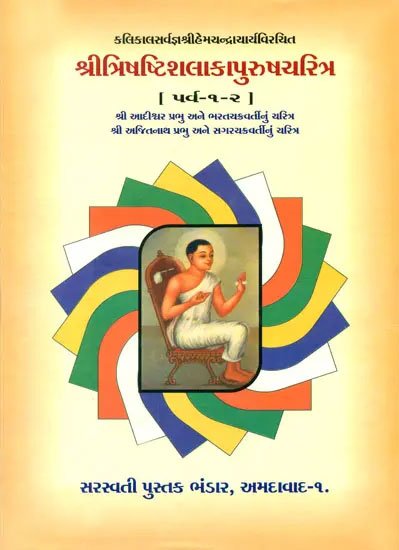Trishashti Shalaka Purusha Caritra
by Helen M. Johnson | 1931 | 742,503 words
This page describes Description of Vaitadhya which is the fifth part of chapter III of the English translation of the Adisvara-caritra, contained within the “Trishashti Shalaka Purusha Caritra”: a massive Jain narrative relgious text composed by Hemacandra in the 12th century. Adisvara (or Rishabha) in jainism is the first Tirthankara (Jina) and one of the 63 illustrious beings or worthy persons.
Part 5: Description of Vaitāḍhya
Taking their families and all their retinue and ascending the best of cars, they went to Vaitāḍhya. They landed on Mt. Vaitāḍhya which is kissed by the mass of waves of the Lavaṇa Ocean at its borders, placed like a measuring-rod between the east and west quarters; a boundary between the northern and southern parts of Bharata, fifty yojanas wide north and south; buried six and a quarter yojanas in the earth, twenty-five yojanas high; embraced on all sides by the Gaṅgā and Sindhu rivers as if by Mt. Hima with arms stretched out from afar; possessing caves named Khaṇḍaprapātā and Tamisrā that were like houses of pleasure and rest of the Śrīs of the two halves of Bharata; endowed with wonderful splendor from its peak Siddhāyatana having the eternal images, like Sumeru with its crest; possessing nine peaks made of various jewels, lofty pleasure-grounds of the gods, resembling the nine Graiveyaka-heavens; supporting two rows of dwellings of the Vyantaras on the north and south sides, like garments, twenty yojanas above the ground; made of beautiful silver slabs from base to peak, like an anklet that had fallen from heaven to earth; calling them frequently from afar, as it were, by its arms of large tree-tops shaken by the wind.
Ten yojanas above the earth, King Nami made fifty cities on the mountain in a southern row. Prākkinnara, Naragīta, Bāhuketupura, Puṇḍarīka, Haritketu, Setuketupura, Sarpāriketunagara, Śrībāhu, Śrīgṛha, Lohārgala, Arijaya, Svargalīlāpura, Vajrārgala, Vajravimokanagara, Mahīsāra, Purañjaya, Sukṛtamukhī, Caturmukhī, Bahumukhā, Ratā, Viratā, Ākhaṇḍalapura, Vilāsayonipattana, Aparājita, Kāñcidāma, Suvinaya, Kṣemaṅkara, Sahacihnapura, Kusumapurī, Sañjayanti, Śakrapura, Jayantī, Vaijayantī, Vijayā, Kṣemaṅkarī, Candrabhāsapura, Lavibhāsapura, Saptabhūtalāvāsa, Suvicitra, Mahāghna, Citrakūṭa, Trikūṭaka, Vaiśravaṇakuṭa, Śaśipura, Ravipura, Vimukhī, Vāhinī, Sumukhī, Nityodyotinī, and Nami himself lived in Śrīrathanūpuracakravāla, the capital city among these cities.
In the same way Vinami made at once sixty cities in a northern row at the command of the Nāga-king. Puryarjunī, Vāruṇī, Vairisaṃhāriṇī, Kailāsavāruṇī, Vidyuddīpta, Kilikila, Cārucūḍāmaṇi, Candrabhābhūṣaṇa, Vaṃśavat, Kusumacūla, Haṃsagarbha, Meghaka, Śaṅkara, Lakṣmiharmya, Cāmara, Vimala, Asumatkṛta, Śivamandira, Vasumatī, Sarvasiddhastuta, Sarvaśatruñjaya, Ketumālāṅkanagara, Indrakānta, Mahānandana, Aśoka, Vītaśoka, Viśokaka, Sukhāloka, Alakatilaka, Nabhastilaka, Madira, Kumudakunda, Gaganavallabha, Yuvatītilaka, Avanītilaka, Sagandharva, Muktahāra, Animiṣaviṣṭapa, Agnijvālā, Gurujvālā, Śrīniketapura, Jayaśrīnivāsa, Ratnakuliśapattana, Vasiṣṭhāśraya, Draviṇajaya, Sabhadraka, Bhadrāsadyapura, Phenaśikhara, Gokṣīravaraśikhara, Varyakṣobhaśikhara, Giriśikharaka, Dharaṇīvāraṇī, Sudarśanapura, Durga, Durdhara, Māhendra, Vijaya, Sugandhinī Suratanāgarapura, and Ratnapura. Vinami himself, who had resorted to Dharaṇendra, inhabited the city Gaganavallabha, the capital of these.
The two rows of Vidyādhara-cities looked very magnificent, as if the Vyantara rows above were reflected below. After making many villages and suburbs, they established communities according to the suitability of place. The communities there were called by the same name as the community from which the men had been brought and put there. Then Nami and Vinami established the Lord, the son of Nābhi, in these cities in the assembly as in their own minds. “Do not let the Vidyādharas, insolent because of their vidyās, show disrespect.” Dharaṇendra instructed them about the law as follows: “If any insolent persons show disrespect or do injury to the Jinas, or the Jinas’ shrines, or to those who will attain mokṣa in this birth, or to any ascetics engaged in pratimā, the vidyās will abandon them at once, just as wealth abandons lazy people. Whoever kills a man with his wife, or enjoys women against their will, the vidyās will abandon him at once.” After proclaiming aloud this law to last so long as the moon, the Master of the Nāgas had it inscribed in edicts on the jeweled walls. After installing them by his favor in the lordship of the Vidyādharas and after laying down the law, the Indra Dharaṇa departed.
There were sixteen classes named after their respective vidyās: Gaureyas from the name of the Gaurīs; Manupūrvakas from Manus; Gāndhāras from Gandhārīs; Mānavas from Mānavīs; Kauśikīpūrvakas are known from the vidyās Kauśikīs; Bhūmituṇḍakas are named from the vidyās Bhūmituṇḍās; Mūlavīryakas are known from the vidyās Mūlavīryās; Śaṅkukas from the Śaṅkukās; and Pāṇḍukas from the Pāṇḍukīs; Kālikeyas from the Kālīs; Śvapākakas from Śvapākīs; Mātaṅgas from Mātaṅgīs; Pārvatas from the Pārvatīs; Vaṃśālayas named from the Vaṃśālayās; Pāṃsumūlakas known from the Pāṃsumūlāvidyās; and Vṛkṣamūlakas from the vidyās Vṛksamūlās.[1]
After dividing them, King Nami took eight classes of the Vidyādharas and Vinami took eight. With devotion they established divinities presiding over the vidyās in each class just as in their own hearts. They constantly observed the suitable occasions for pūjā to Ṛṣabha Svāmin’s image and, without any injury to dharma, enjoyed delights like gods. Sometimes they, like another Śakra and Īśāna, sported with beautiful women in the lattice window-recesses on the wall around the continent. Sometimes in the gardens, Nandana, etc., on Sumeru’s peak they wandered, always joyful, free as air. Sometimes they went to the holy places of Nandīśvara, etc., for worship of the eternal images. That is the fruit of a layman’s prosperity. Sometimes in the zones Videha, etc., they went to the samavasaraṇa of the holy Arhats and drank the nectar of their speech. Sometimes they listened to the preaching of dharma by flying ascetics, their ears pricked up like young deer listening to a song. Possessing right belief, their treasuries undiminished, surrounded by Vidyādharas, they exercised sovereignty fittingly without injury to the three things (dharma, wealth, love).
Footnotes and references:
[1]:
One would expect these 16 classes of vidyās to correspond to the names of the 16 vidyādevīs named in Abhi. 2. 153-4, but they do not. The whole subject of the vidyās needs investigation.
